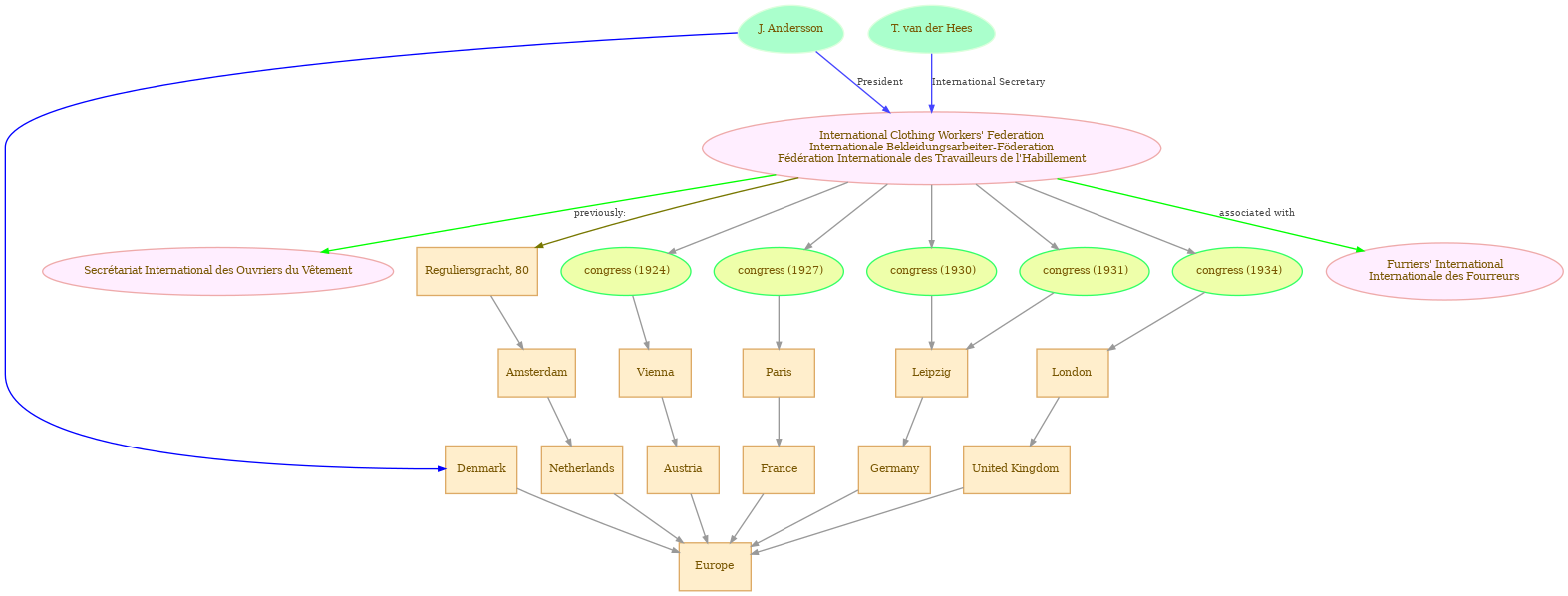




International Clothing Workers' Federation
International Clothing Workers' Federation, Internationale Bekleidungsarbeiter-Föderation, Fédération Internationale des Travailleurs de l'HabillementFounded: 1893
Sources: HB 1929, HB 1936, HB 1938
Officers
The direction rests with the International Bureau consisting of seven members. The Management Committee consists of the International Secretary and two members of the national organisation, of which the Secretary is a member. La direction incombe à un Bureau international comprenant six membres ordinaires et un membre extraordinaire. Parmi ces membres figurent le Président (J. Andersson (Danemark)), et le Secrétaire international. Le Comité de Direction comprend le Secrétaire international (T. van der Hees) et deux membres de l'Organisation nationale, dont le Secrétaire (HB 1936). The administration is in the hands of an International Bureau consisting of six ordinary members and one extraordinary member. These members include the Chairman, Mr. J. Andersson (Denmark) and the International Secretary. The Committee of Management consists of the International Secretary, Mr. T. van Der Heeg and two members of the National Organisation, including the Secretary. Finances: Expenditure is defrayed by annual contributions (three Dutch cents per member) from the affiliated organisations. (HB 1938)- J. Andersson President 1936
- T. van der Hees International Secretary (Secretary) 1929
Seats
Relationships with other Organisations
- this organisation (International Clothing Workers' Federation) associated with Furriers' International
- this organisation (International Clothing Workers' Federation) previously: Secrétariat International des Ouvriers du Vêtement
Members in these countries
National clothing workers' trade unions in various countries. (HB 1929) Syndicats nationaux des travailleurs de l'habillement des pays suivants (HB 1936): National clothing workers' trade unions in the following countries: Union of South Africa, Belgium, the United Kingdom, Bulgaria, Czechoslovakia, Denmark, Estonia, Finland, France, Hungary, the Netherlands, Norway, Poland, Rumania, Sweden, Switzerland, the United States of America, Yugoslavia.Austria (1936-1938) , Belgium (since 1936) , Bulgaria (since 1936) , Czechoslovakia (since 1936) , Denmark (since 1936) , Estonia (since 1936) , Finland (since 1936) , France (since 1936) , Germany (1936-1938) , Hungary (since 1936) , Netherlands (since 1936) , Norway (since 1936) , Poland (since 1936) , Romania (since 1936) , Sweden (since 1936) , Switzerland (since 1936) , Union of South Africa (since 1938) , United Kingdom (since 1936) , United States of America (since 1936) , Yugoslavia (since 1936) ,
Congresses
- 1924-1924 Vienna: Austria
- 1927-1927 Paris: France
- 1930-1930 Leipzig: Germany
- 1931-1931 Leipzig: Germany
- 1934-1934 London: United Kingdom
Object
To combine and develop the trade unions of clothing workers of all countries. Grouper et développer les syndicats de travailleurs de l'habillement de tous les pays et défendre leurs intérêts économiques et sociaux. (HB 1936) To combine and develop the trade unions of clothing workers of all countries, and defend their economic and social interests. (HB 1938)Finances
Expenditure is defrayed by annual contributions (three Dutch cents per member)from the affiliated organisations. Les dépenses sont couvertes par les cotisations annuelles (3 cents néerlandais par membre) que versent les organisations affiliées. (HB 1936) Expenditure is defrayed by annual contributions (three Dutch cents per member) from the affiliated organisations. (HB 1938)General facts
From 1893 to 1920, the seat of the Federation was in Berlin. Since that year, the Secretariat has been in Amsterdam. The last International Congresses were held in Vienna in 1924 and Paris in 1927. The Furriers' International amalgamated with the International Clothing Workers' Federation in 1925. De 1893 à 1920, le siège de la Fédération, a été à Berlin. Depuis 1920, il est à Amsterdam. Les derniers congrès internationaux ont été tenus à Vienne en 1924, à Paris en 1927, et à Leipzig en 1930. L'Internationale des Fourreurs a fusionné, en 1925, avec la Fédération internationale des Travailleurs de l'habillement. Le dernier Congrès a été tenu à Leipzig en 1931. (HB 1936) From 1893 to 1920, the seat of the Federation was at Berlin. Since that year, the Secretariat has been at Amsterdam. The last International Congresses were held at Vienna in 1924, at Paris in 1927, at Leipzig in 1930, and at London in 1934. The Furriers' International amalgamated with the International Clothing Workers' Federation in 1925. The last Congress was held at Leipzig in 1931. (HB 1938)Publications
Bi-monthly Journal (in English and French). Un bulletin publié à intervalles irréguliers; statistiques et autres informations (en français et en anglais). (HB 1936) A Bulletin, published at irregular intervals; statistics and other information (in English and French). (HB 1938)Activities
Reports on strikes, wage disputes, and important events in the various organisations; arranging international relief action; protecting the interests of the members and regulating the transfer of members from the organisation of one country into that of another; holding international congresses and conferences. Rapport sur les grèves, les conflits concernant les salaires et les événements importants survenus dans les diverses organisations; organisation d'actions internationales de secours; protection des intérêts des membres et réglementation du transfert de membres d'une organisation d'un pays dans une organisation d'un autre pays; congrès et conférences internationaux. (HB 1936) Reports on strikes, wage disputes and important events in the various organisations; arranging international relief action; protecting the interests of the members and regulating the transfer of members from the organisation of one country into that of another; holding of international congresses and conferences. (HB 1938)Network
